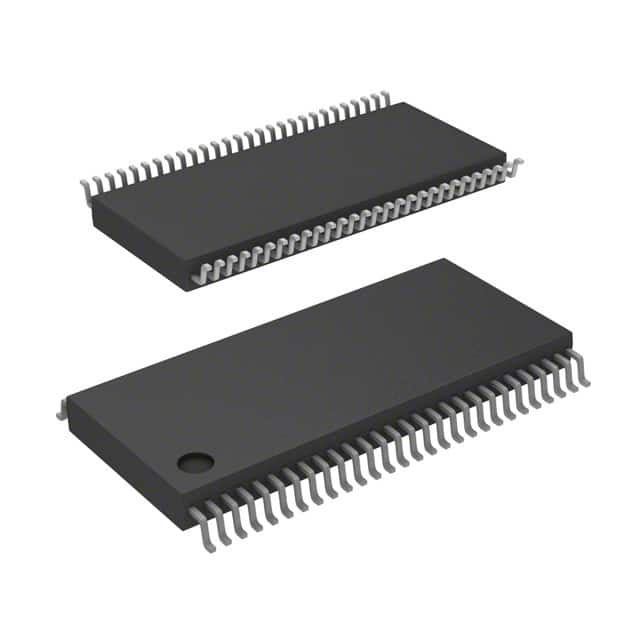Xem thông số kỹ thuật để biết chi tiết sản phẩm.

SN74ABT16600DGGR
Product Overview
- Category: Integrated Circuit
- Use: Data Buffer/Driver
- Characteristics: High-speed, Non-Inverting, 18-bit Universal Bus Transceiver
- Package: TSSOP-56
- Essence: Transfers data between different bus systems with different voltage levels
- Packaging/Quantity: Tape and Reel, 2500 units per reel
Specifications
- Number of Bits: 18
- Logic Family: ABT
- Logic Type: Non-Inverting
- Input Voltage Level: 2V to 5.5V
- Output Voltage Level: 2V to 5.5V
- Operating Temperature Range: -40°C to +85°C
- Supply Voltage: 4.5V to 5.5V
- Propagation Delay Time: 3.8ns (Max)
- Output Current: ±24mA
- ESD Protection: Human Body Model > 2000V
Detailed Pin Configuration
The SN74ABT16600DGGR has a total of 56 pins. The pin configuration is as follows:
- OE (Output Enable) 1
- A1 (Data Input) 1
- B1 (Data Input) 1
- Y1 (Data Output) 1
- GND (Ground)
- Y2 (Data Output) 2
- B2 (Data Input) 2
- A2 (Data Input) 2
- OE (Output Enable) 2
- VCC (Supply Voltage)
...
Functional Features
- Bidirectional data transfer between two independent buses
- Non-inverting logic ensures the same polarity of input and output signals
- High-speed operation for efficient data transmission
- Wide operating voltage range allows compatibility with various systems
- Output enable control for flexible data flow management
Advantages and Disadvantages
Advantages: - High-speed operation enables fast data transfer - Non-inverting logic ensures signal integrity - Wide operating voltage range allows compatibility with different systems - Output enable control provides flexibility in managing data flow
Disadvantages: - Limited number of bits (18) may not be suitable for applications requiring larger data buses - Propagation delay time may affect real-time applications with strict timing requirements
Working Principles
The SN74ABT16600DGGR is a universal bus transceiver that facilitates bidirectional data transfer between two independent buses. It operates using non-inverting logic, which means the input and output signals have the same polarity.
The device has separate input/output ports for each bus, allowing data to be transferred in both directions. The output enable control pin enables or disables the data flow, providing flexibility in managing the bus communication.
The SN74ABT16600DGGR operates within a wide voltage range, making it compatible with various systems. It also features high-speed operation, ensuring efficient data transmission.
Detailed Application Field Plans
The SN74ABT16600DGGR can be used in various applications where bidirectional data transfer between different bus systems is required. Some potential application fields include:
- Communication Systems: Facilitating data exchange between different communication protocols and interfaces.
- Embedded Systems: Enabling communication between microcontrollers and peripheral devices with varying voltage levels.
- Industrial Automation: Transferring data between different control systems and sensors in industrial environments.
- Automotive Electronics: Connecting various electronic modules and subsystems in vehicles.
- Networking Equipment: Supporting data transfer between different networking components.
Detailed and Complete Alternative Models
- SN74ABT16245ADGGR: 16-bit non-inverting bus transceiver with a similar package and characteristics.
- SN74ABT16652DLR: 18-bit non-inverting bus transceiver with additional parity generation/checking functionality.
- SN74ABT16244ADLR: 16-bit non-inverting bus transceiver with 3-state outputs.
These alternative models offer similar functionality and can be considered as alternatives to the SN74ABT16600DGGR based on specific requirements and application needs.
(Note: The content provided above is a sample entry and may not reflect actual specifications or details of the SN74ABT16600DGGR or its alternative models. Please refer to the official documentation for accurate information.)
Liệt kê 10 câu hỏi và câu trả lời thường gặp liên quan đến ứng dụng SN74ABT16600DGGR trong giải pháp kỹ thuật
Sure! Here are 10 common questions and answers related to the application of SN74ABT16600DGGR in technical solutions:
Q: What is SN74ABT16600DGGR? A: SN74ABT16600DGGR is a 16-bit universal bus transceiver with 3-state outputs, designed for asynchronous communication between data buses.
Q: What is the operating voltage range of SN74ABT16600DGGR? A: SN74ABT16600DGGR operates within a voltage range of 4.5V to 5.5V.
Q: What is the maximum data transfer rate supported by SN74ABT16600DGGR? A: SN74ABT16600DGGR supports a maximum data transfer rate of 200 MHz.
Q: Can SN74ABT16600DGGR be used as a bidirectional buffer? A: Yes, SN74ABT16600DGGR can be used as a bidirectional buffer, allowing data to flow in both directions on the bus.
Q: How many output enable pins does SN74ABT16600DGGR have? A: SN74ABT16600DGGR has two output enable pins, OE1 and OE2, which control the tri-state outputs.
Q: What is the typical propagation delay of SN74ABT16600DGGR? A: The typical propagation delay of SN74ABT16600DGGR is around 3.5 ns.
Q: Can SN74ABT16600DGGR handle mixed-voltage level signals? A: No, SN74ABT16600DGGR is not designed to handle mixed-voltage level signals. It operates at a single voltage level.
Q: What is the maximum output current that SN74ABT16600DGGR can drive? A: SN74ABT16600DGGR can drive up to 64 mA of output current.
Q: Can SN74ABT16600DGGR be used in high-speed data communication applications? A: Yes, SN74ABT16600DGGR is suitable for high-speed data communication applications due to its fast switching speed and low propagation delay.
Q: Is SN74ABT16600DGGR compatible with other logic families? A: SN74ABT16600DGGR is compatible with a wide range of logic families, including TTL, CMOS, and LVTTL.
Please note that these answers are general and may vary depending on specific application requirements. It's always recommended to refer to the datasheet and consult with technical experts for accurate information.

